Land Cover Disaggregated Fire Occurrence and Particulate Matter2.5 Relationship in the Mekong Region: A Comprehensive Study
Abstract
1. Introduction
2. Materials and Methods
2.1. Study Area
2.2. Datasets
2.2.1. VIIRS Active Fire Hotspots 375 m
2.2.2. MODIS Land Cover Type Product
2.2.3. Global PM2.5 Estimates
2.3. Methods
3. Results
3.1. Seasonal Fire Pattern in the Mekong Countries 2012–2020
3.2. Fire Patterns per Land Cover
3.3. Monthly Correlation between Fire Counts and PM2.5 Concentrations
3.4. Monthly Correlation between FRP and PM2.5 Concentration
4. Discussion
5. Conclusions
Author Contributions
Funding
Data Availability Statement
Conflicts of Interest
References
- Lee, H.-H.; Iraqui, O.; Gu, Y.; Yim, S.H.-L.; Chulakadabba, A.; Tonks, A.Y.-M.; Yang, Z.; Wang, C. Impacts of air pollutants from fire and non-fire emissions on the regional air quality in Southeast Asia. Atmos. Chem. Phys. 2018, 18, 6141–6156. [Google Scholar] [CrossRef]
- Groß, S.; Esselborn, M.; Weinzierl, B.; Wirth, M.; Fix, A.; Petzold, A. Aerosol classification by airborne high spectral resolution lidar observations. Atmos. Chem. Phys. 2013, 13, 2487–2505. [Google Scholar] [CrossRef]
- Vicente, A.; Alves, C.; Calvo, A.I.; Fernandes, A.P.; Nunes, T.; Monteiro, C.; Almeida, S.M.; Pio, C. Emission factors and detailed chemical composition of smoke particles from the 2010 wildfire season. Atmos. Environ. 2013, 71, 295–303. [Google Scholar] [CrossRef]
- Curtis, L.; Rea, W.; Smith-Willis, P.; Fenyves, E.; Pan, Y. Adverse health effects of outdoor air pollutants. Environ. Int. 2006, 32, 815–830. [Google Scholar] [CrossRef] [PubMed]
- Mannucci, P.; Franchini, M. Health Effects of Ambient Air Pollution in Developing Countries. Int. J. Environ. Res. Public Health 2017, 14, 1048. [Google Scholar] [CrossRef]
- Aguilera, R.; Corringham, T.; Gershunov, A.; Benmarhnia, T. Wildfire smoke impacts respiratory health more than fine particles from other sources: Observational evidence from Southern California. Nat. Commun. 2021, 12, 1493. [Google Scholar] [CrossRef] [PubMed]
- Junpen, A.; Roemmontri, J.; Boonman, A.; Cheewaphongphan, P.; Thao, P.T.B.; Garivait, S. Spatial and Temporal Distribution of Biomass Open Burning Emissions in the Greater Mekong Subregion. Climate 2020, 8, 90. [Google Scholar] [CrossRef]
- Quah, E.; Johnston, D. Forest fires and environmental haze in Southeast Asia: Using the ‘stakeholder’ approach to assign costs and responsibilities. J. Environ. Manag. 2001, 63, 181–191. [Google Scholar] [CrossRef]
- Reddington, C.L.; Conibear, L.; Robinson, S.; Knote, C.; Arnold, S.R.; Spracklen, D.V. Air Pollution from Forest and Vegetation Fires in Southeast Asia Disproportionately Impacts the Poor. GeoHealth 2021, 5, e2021GH000418. [Google Scholar] [CrossRef]
- Spruce, J.; Bolten, J.; Mohammed, I.N.; Srinivasan, R.; Lakshmi, V. Mapping Land Use Land Cover Change in the Lower Mekong Basin From 1997 to 2010. Front. Environ. Sci. 2020, 8, 21. Available online: https://www.frontiersin.org/articles/10.3389/fenvs.2020.00021 (accessed on 1 June 2024). [CrossRef]
- Vadrevu, K.P.; Lasko, K.; Giglio, L.; Schroeder, W.; Biswas, S.; Justice, C. Trends in Vegetation fires in South and Southeast Asian Countries. Sci. Rep. 2019, 9, 7422. [Google Scholar] [CrossRef] [PubMed]
- Mittelman, A. Secondary Forests in the Lower Mekong Subregion: An Overview of their Extent, Roles and Importance. J. Trop. For. Sci. 2001, 13, 20. Available online: http://www.jstor.org/stable/43582366 (accessed on 1 June 2024).
- Hongthong, A.; Nanthapong, K.; Kanabkaew, T. Biomass burning emission inventory of multi-year PM 10 and PM 2.5 with high temporal and spatial resolution for Northern Thailand. Sci. Asia 2022, 48, 302–309. [Google Scholar] [CrossRef]
- Thepnuan, D.; Chantara, S.; Lee, C.T.; Lin, N.H.; Tsai, Y.I. Molecular markers for biomass burning associated with the characterization of PM2.5 and component sources during dry season haze episodes in Upper South East Asia. Sci. Total Environ. 2019, 658, 708–722. [Google Scholar] [CrossRef] [PubMed]
- Fan, W.; Li, J.; Han, Z.; Wu, J.; Zhang, S.; Zhang, C.; Li, J. Impacts of biomass burning in Southeast Asia on aerosols over the low-latitude plateau in China: An analysis of a typical pollution event. Front. Environ. Sci. 2023, 11, 1101745. [Google Scholar] [CrossRef]
- Yin, S.; Wang, X.; Zhang, X.; Guo, M.; Miura, M.; Xiao, Y. Influence of biomass burning on local air pollution in mainland Southeast Asia from 2001 to 2016. Environ. Pollut. 2019, 254, 112949. [Google Scholar] [CrossRef] [PubMed]
- Fu, Y.; Li, R.; Wang, X.; Bergeron, Y.; Valeria, O.; Chavardès, R.D.; Wang, Y.; Hu, J. Fire Detection and Fire Radiative Power in Forests and Low-Biomass Lands in Northeast Asia: MODIS versus VIIRS Fire Products. Remote Sens. 2020, 12, 2870. [Google Scholar] [CrossRef]
- Ichoku, C.; Ellison, L. Global top-down smoke-aerosol emissions estimation using satellite fire radiative power measurements. Atmos. Chem. Phys. 2014, 14, 6643–6667. [Google Scholar] [CrossRef]
- Kaiser, J.W.; Heil, A.; Andreae, M.O.; Benedetti, A.; Chubarova, N.; Jones, L.; Morcrette, J.-J.; Razinger, M.; Schultz, M.G.; Suttie, M.; et al. Biomass burning emissions estimated with a global fire assimilation system based on observed fire radiative power. Biogeosciences 2012, 9, 527–554. [Google Scholar] [CrossRef]
- Nguyen, H.M.; Wooster, M.J. Advances in the estimation of high Spatio-temporal resolution pan-African top-down biomass burning emissions made using geostationary fire radiative power (FRP) and MAIAC aerosol optical depth (AOD) data. Remote Sens. Environ. 2020, 248, 111971. [Google Scholar] [CrossRef]
- Wooster, M.J.; Roberts, G.; Perry GL, W.; Kaufman, Y.J. Retrieval of biomass combustion rates and totals from fire radiative power observations: FRP derivation and calibration relationships between biomass consumption and fire radiative energy release. J. Geophys. Res. 2005, 110, D24311. [Google Scholar] [CrossRef]
- Zhang, X.; Kondragunta, S.; Ram, J.; Schmidt, C.; Huang, H.-C. Near-real-time global biomass burning emissions product from geostationary satellite constellation: GLOBAL BIOMASS BURNING EMISSIONS. J. Geophys. Res. Atmos. 2012, 117, D14201. [Google Scholar] [CrossRef]
- Nuthammachot, N.; Askar, A.; Stratoulias, D.; Wicaksono, P. Combined use of Sentinel-1 and Sentinel-2 data for improving above-ground biomass estimation. Geocarto Int. 2022, 37, 366–376. [Google Scholar] [CrossRef]
- Schroeder, W.; Oliva, P.; Giglio, L.; Csiszar, I.A. The New VIIRS 375 m active fire detection data product: Algorithm description and initial assessment. Remote Sens. Environ. 2014, 143, 85–96. [Google Scholar] [CrossRef]
- Hantson, S.; Arneth, A.; Harrison, S.P.; Kelley, D.I.; Prentice, I.C.; Rabin, S.S.; Archibald, S.; Mouillot, F.; Arnold, S.R.; Artaxo, P.; et al. The status and challenge of global fire modelling. Biogeosciences 2016, 13, 3359–3375. [Google Scholar] [CrossRef]
- Handschuh, J.; Erbertseder, T.; Schaap, M.; Baier, F. Estimating PM2.5 surface concentrations from AOD: A combination of SLSTR and MODIS. Remote Sens. Appl. Soc. Environ. 2022, 26, 100716. [Google Scholar] [CrossRef]
- van Donkelaar, A.; Hammer, M.S.; Bindle, L.; Brauer, M.; Brook, J.R.; Garay, M.J.; Hsu, N.C.; Kalashnikova, O.V.; Kahn, R.A.; Lee, C.; et al. Monthly Global Estimates of Fine Particulate Matter and Their Uncertainty. Environ. Sci. Technol. 2021, 55, 15287–15300. [Google Scholar] [CrossRef]
- Ding, Y.; Li, S.; Xing, J.; Li, X.; Ma, X.; Song, G.; Teng, M.; Yang, J.; Dong, J.; Meng, S. Retrieving hourly seamless PM2.5 concentration across China with physically informed spatiotemporal connection. Remote Sens. Environ. 2024, 301, 113901. [Google Scholar] [CrossRef]
- He, Q.; Wang, M.; Yim, S.H.L. The spatiotemporal relationship between PM 2.5 and aerosol optical depth in China: Influencing factors and implications for satellite PM 2.5 estimations using MAIAC aerosol optical depth. Atmos. Chem. Phys. 2021, 21, 18375–18391. [Google Scholar] [CrossRef]
- Vadrevu, K.; Eaturu, A. Trends in Nighttime Fires in South/Southeast Asian Countries. Atmosphere 2024, 15, 85. [Google Scholar] [CrossRef]
- Chuan, G.K. The Climate of Southeast Asia. Phys. Geogr. Southeast Asia 2005, 4, 80. [Google Scholar] [CrossRef]
- Vadrevu, K.P.; Ohara, T.; Justice, C. (Eds.) Biomass Burning in South and Southeast Asia: Impacts on the Biosphere; CRC Press: Boca Raton, FL, USA, 2021; Volume 2. [Google Scholar]
- Li, P.; Xiao, C.; Feng, Z.; Li, W.; Zhang, X. Occurrence frequencies and regional variations in Visible Infrared Imaging Radiometer Suite (VIIRS) global active fires. Glob. Change Biol. 2020, 26, 2970–2987. [Google Scholar] [CrossRef] [PubMed]
- Vadrevu, K.; Lasko, K. Intercomparison of MODIS AQUA and VIIRS I-Band fires and emissions in an agricultural landscape-Implications for air pollution research. Remote Sens. 2018, 10, 978. [Google Scholar] [CrossRef] [PubMed]
- Lu, X.; Zhang, X.; Li, F.; Cochrane, M.A.; Ciren, P. Detection of Fire Smoke Plumes Based on Aerosol Scattering Using VIIRS Data over Global Fire-Prone Regions. Remote Sens. 2021, 13, 196. [Google Scholar] [CrossRef]
- Li, F.; Zhang, X.; Kondragunta, S.; Csiszar, I. Comparison of Fire Radiative Power Estimates from VIIRS and MODIS Observations. J. Geophys. Res. Atmos. 2018, 123, 4545–4563. [Google Scholar] [CrossRef]
- Friedl, M.A.; Sulla-Menashe, D.; Tan, B.; Schneider, A.; Ramankutty, N.; Sibley, A.; Huang, X. MODIS Collection 5 global land cover: Algorithm refinements and characterization of new datasets. Remote Sens. Environ. 2010, 114, 168–182. [Google Scholar] [CrossRef]
- Sulla-Menashe, D.; Friedl, M.A. User Guide to Collection 6 MODIS Land Cover (MCD12Q1 and MCD12C1) Product. 2018; pp. 1–18. Available online: https://lpdaac.usgs.gov/documents/101/MCD12_User_Guide_V6.pdf (accessed on 14 June 2024).
- Adaktylou, N.; Stratoulias, D.; Landenberger, R. Wildfire Risk Assessment Based on Geospatial Open Data: Application on Chios, Greece. ISPRS Int. J. Geo-Inf. 2020, 9, 516. [Google Scholar] [CrossRef]
- Gorelick, N.; Hancher, M.; Dixon, M.; Ilyushchenko, S.; Thau, D.; Moore, R. Google Earth Engine: Planetary-scale geospatial analysis for everyone. Remote Sens. Environ. 2017, 202, 18–27. [Google Scholar] [CrossRef]
- Freedman, D.; Pisani, R.; Purves, R. Statistics, 4th ed.; W.W. Norton & Co.: New York, NY, USA, 2007. [Google Scholar]
- Jones, S.H. Vegetation fire and land use in Southeast Asia: The interpretation of remotely sensed data for Cambodia. Geocarto Int. 1998, 13, 63–73. [Google Scholar] [CrossRef]
- Thet, A.P.P.; Tokuchi, N. Traditional knowledge on shifting cultivation of local communities in Bago Mountains, Myanmar. J. For. Res. 2020, 25, 347–353. [Google Scholar] [CrossRef]
- Rundel, P.W. Forest Habitats and Flora in Lao PDR, Cambodia, and Vietnam. Hanoi: WWF Indochina Programme. 1999. Available online: https://www.researchgate.net/publication/259623025_Forest_Habitats_and_Flora_in_Laos_PDR_Cambodia_and_Vietnam (accessed on 14 June 2024).
- Ratnam, J.; Tomlinson, K.W.; Rasquinha, D.N.; Sankaran, M. Savannahs of Asia: Antiquity, biogeography, and an uncertain future. Philos. Trans. R. Soc. B Biol. Sci. 2016, 371, 20150305. [Google Scholar] [CrossRef]
- Kumar, I.; Bandaru, V.; Yampracha, S.; Sun, L.; Fungtammasan, B. Limiting rice and sugarcane residue burning in Thailand: Current status, challenges and strategies. J. Environ. Manag. 2020, 276, 111228. [Google Scholar] [CrossRef]
- FAO. FAOSTAT Land, Inputs and Sustainability, Land Use. 2022. Available online: https://www.fao.org/faostat/en/#data/RL/visualize (accessed on 14 June 2024).
- Shi, Y.; Tian, Y.; Zang, S.; Yamaguchi, Y.; Matsunaga, T.; Li, Z.; Gu, X. Estimating Biomass Burning Emissions in South Southeast Asia from 2001 to 2017 Based on Satellite Observations In Biomass Burning in South and Southeast Asia, 1st ed.; Vadrevu, K.P., Ohara, T., Justice, C., Eds.; CRC Press: Boca Raton, FL, USA, 2021; pp. 79–93. [Google Scholar] [CrossRef]
- Laurent, P.; Mouillot, F.; Moreno, M.V.; Yue, C.; Ciais, P. Varying relationships between fire radiative power and fire size at a global scale. Biogeosciences 2019, 16, 275–288. [Google Scholar] [CrossRef]
- Arunrat, N.; Pumijumnong, N.; Sereenonchai, S. Air-Pollutant Emissions from Agricultural Burning in Mae Chaem Basin, Chiang Mai Province, Thailand. Atmosphere 2018, 9, 145. [Google Scholar] [CrossRef]
- Sirimongkonlertkun, N. Effect From Open Burning at Greater Mekong Sub-Region Nations to The PM10 Concentration in Northern Thailand: A Case Study of Backword Trajectories in March 2012 at Chiang Rai Province. In Proceedings of the 1st Mae Fah Luang University International Conference, 29–30 November–1 December 2012; pp. 29–30. Available online: https://mfuic2012.mfu.ac.th/electronic_proceeding/Documents/00_PDF/O-SC-D/O-SC-D-008.pdf (accessed on 14 June 2024).
- Brotons, L.; Aquilué, N.; De Cáceres, M.; Fortin, M.J.; Fall, A. How fire history, fire suppression practices and climate change affect wildfire regimes in Mediterranean landscapes. PLoS ONE 2013, 8, e62392. [Google Scholar] [CrossRef]
- Sayedi, S.S.; Abbott, B.W.; Vannière, B.; Leys, B.; Colombaroli, D.; Gil Romera, G.; Słowiński, M.; Aleman, J.C.; Blarquez, O.; Feurdean, A.; et al. Assessing changes in global fire regimes. Fire Ecol. 2024, 20, 1–22. [Google Scholar] [CrossRef]
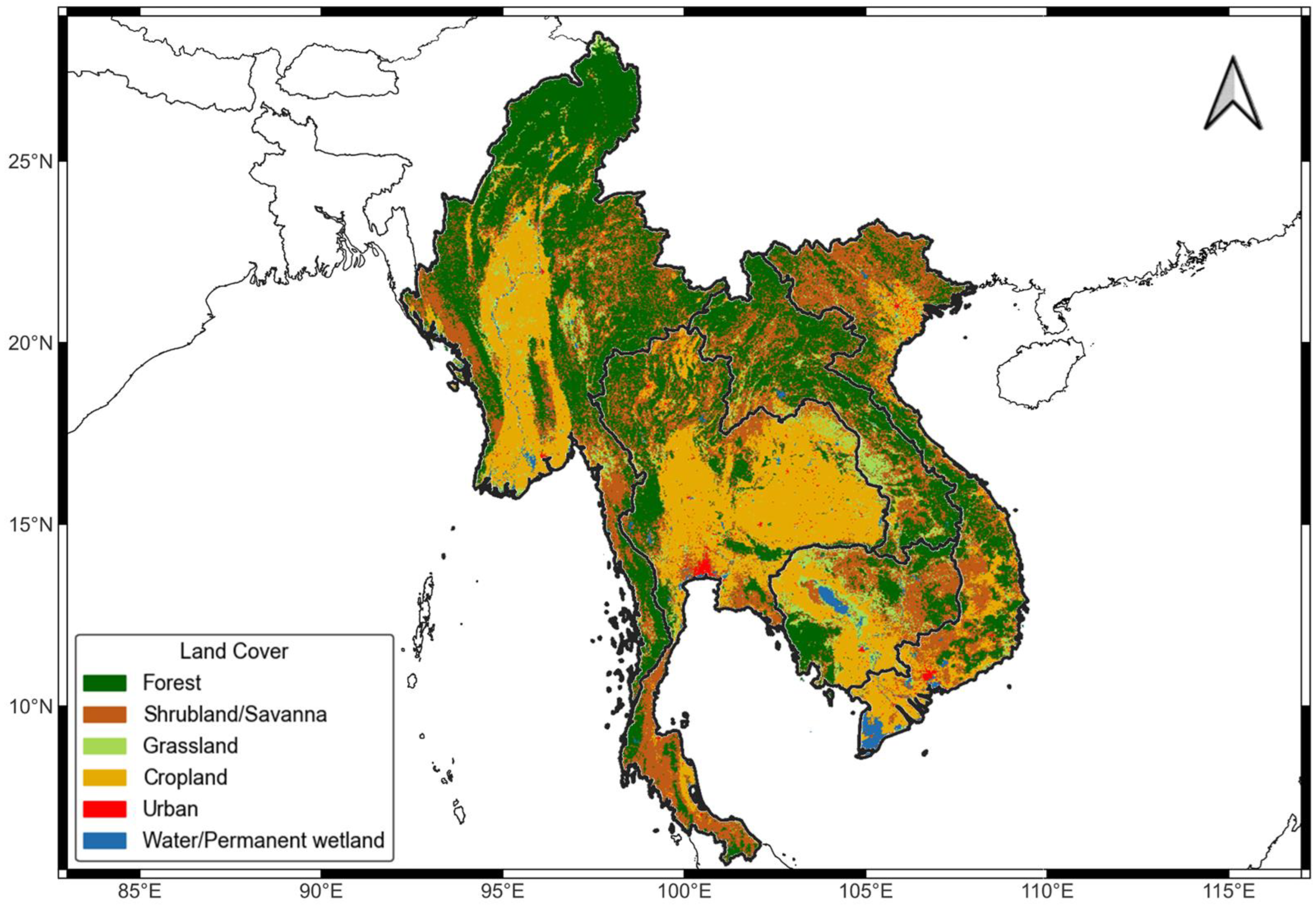

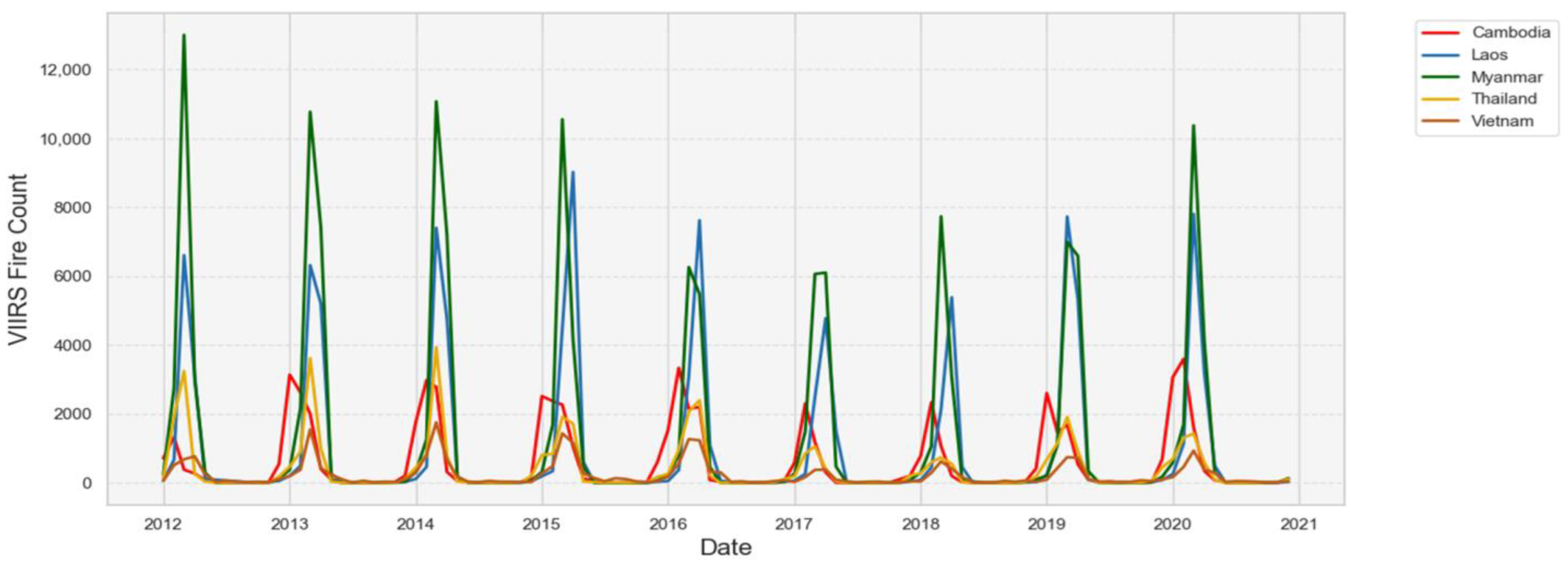
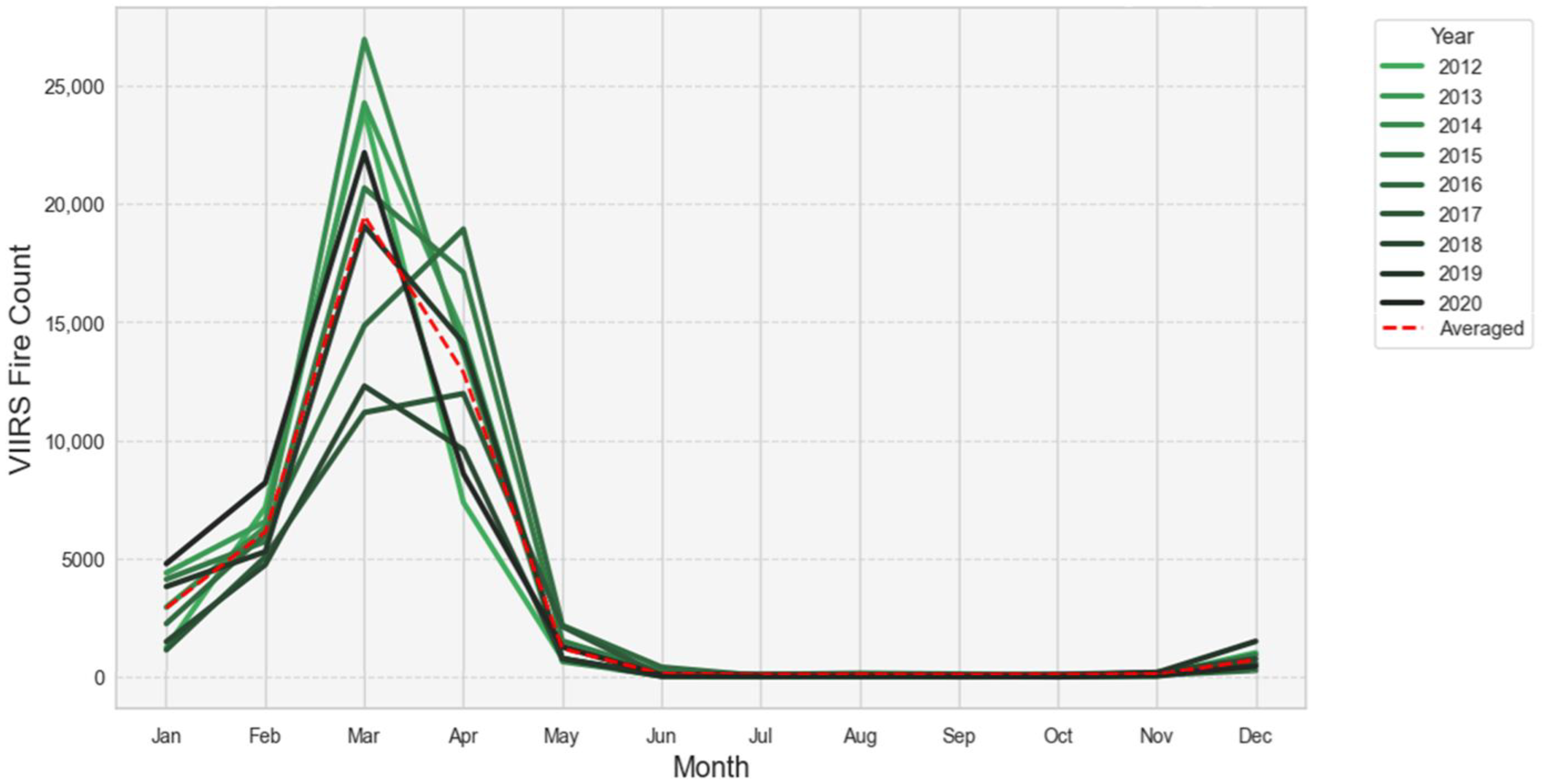
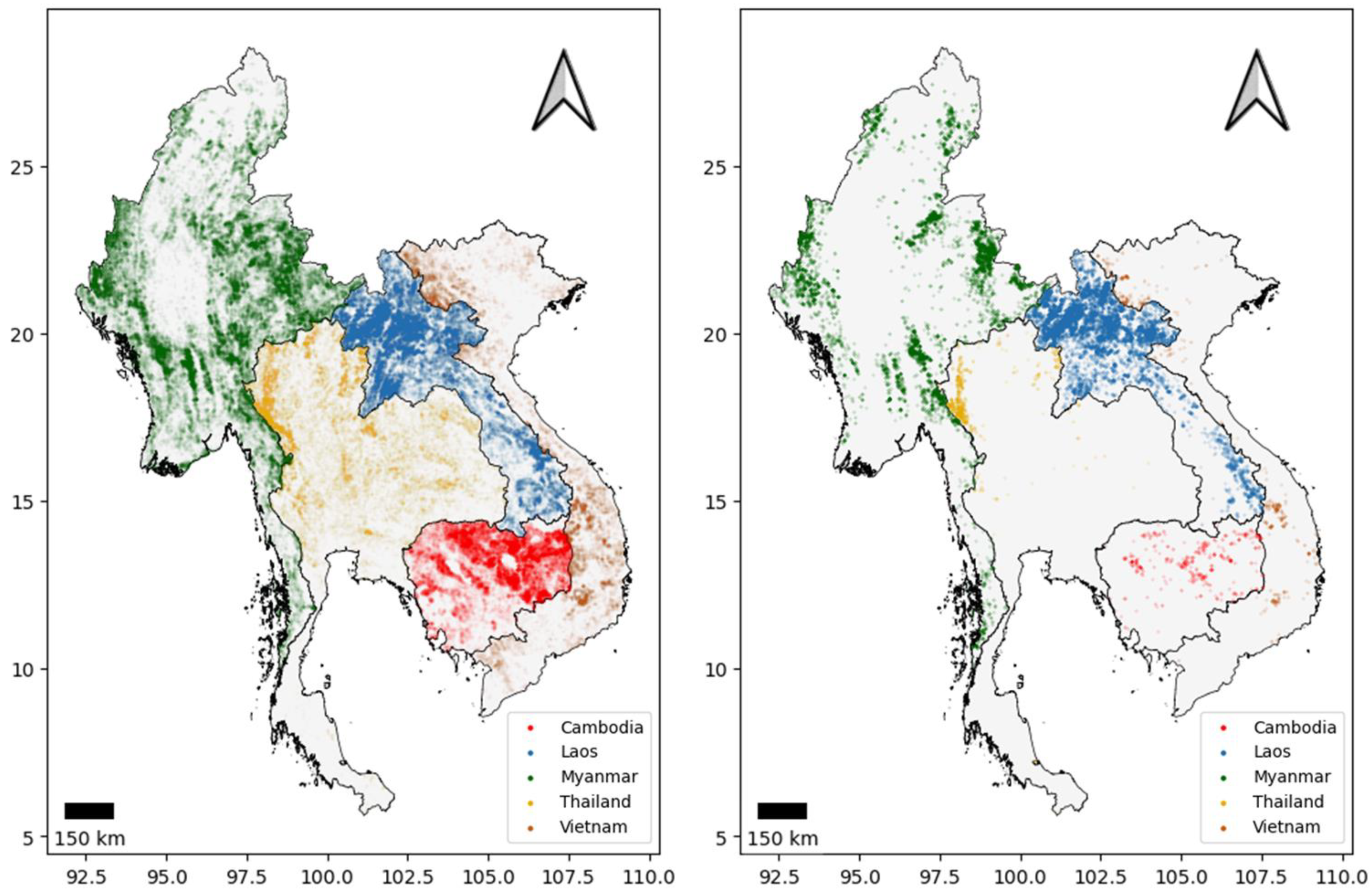
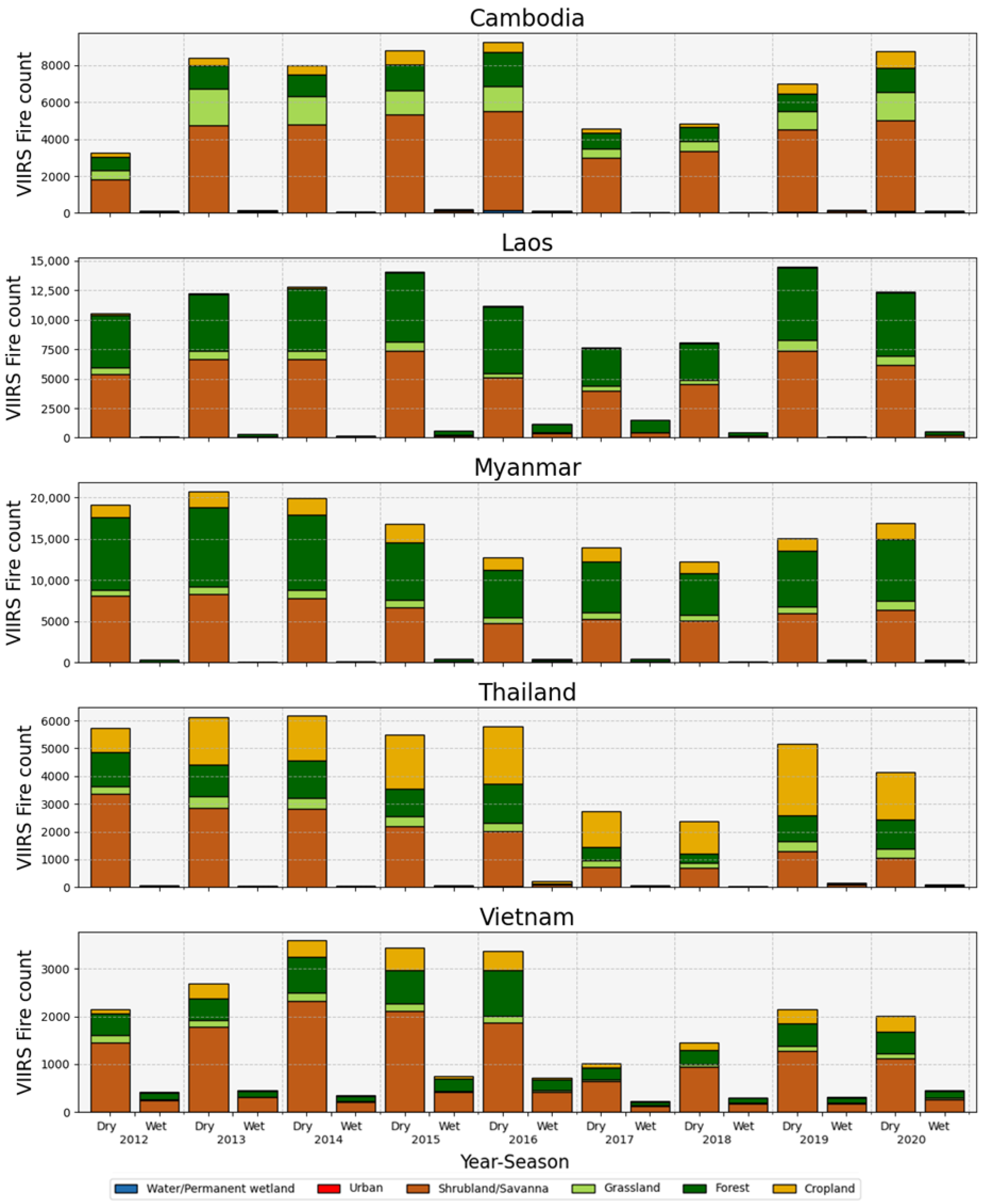
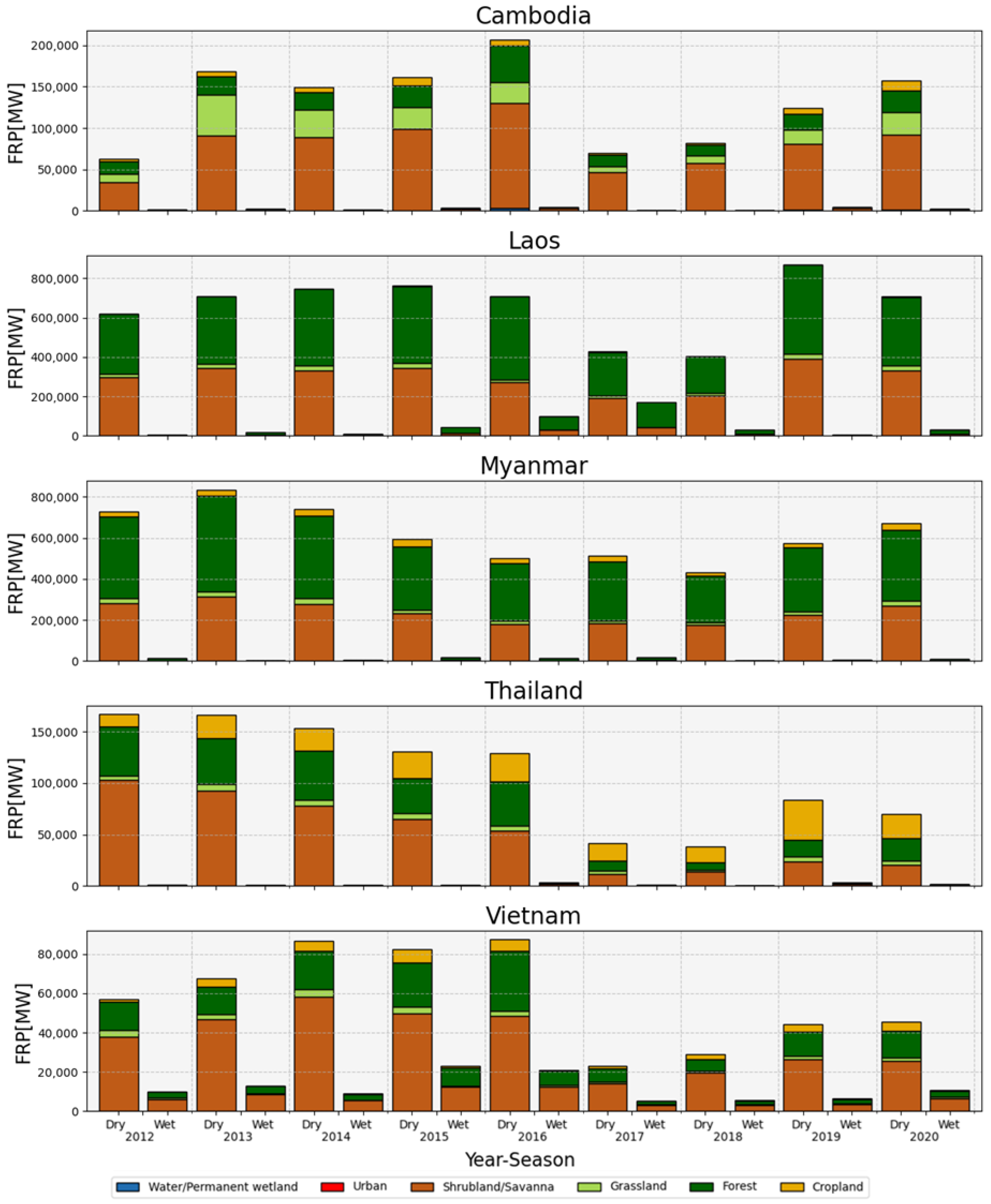
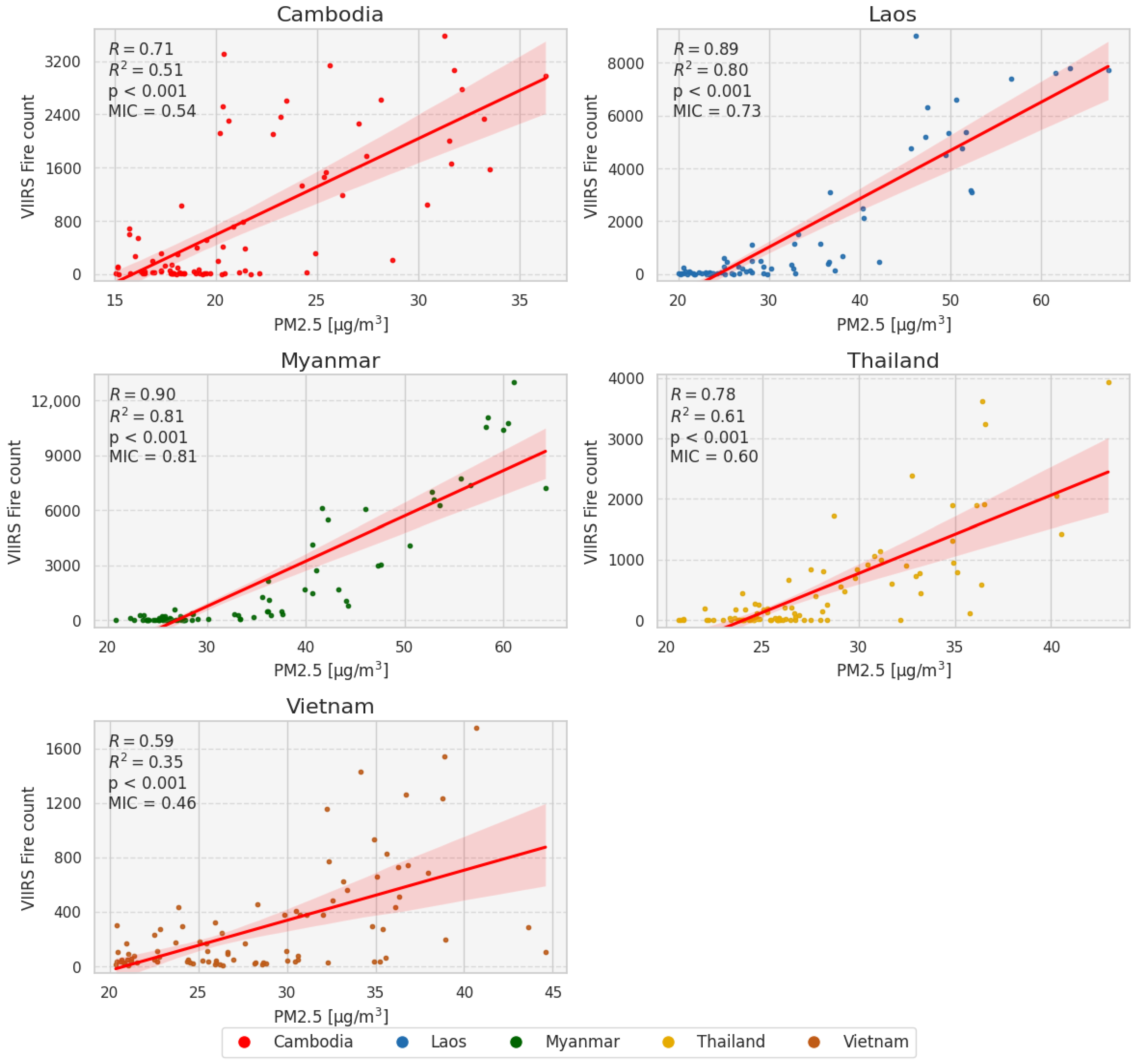

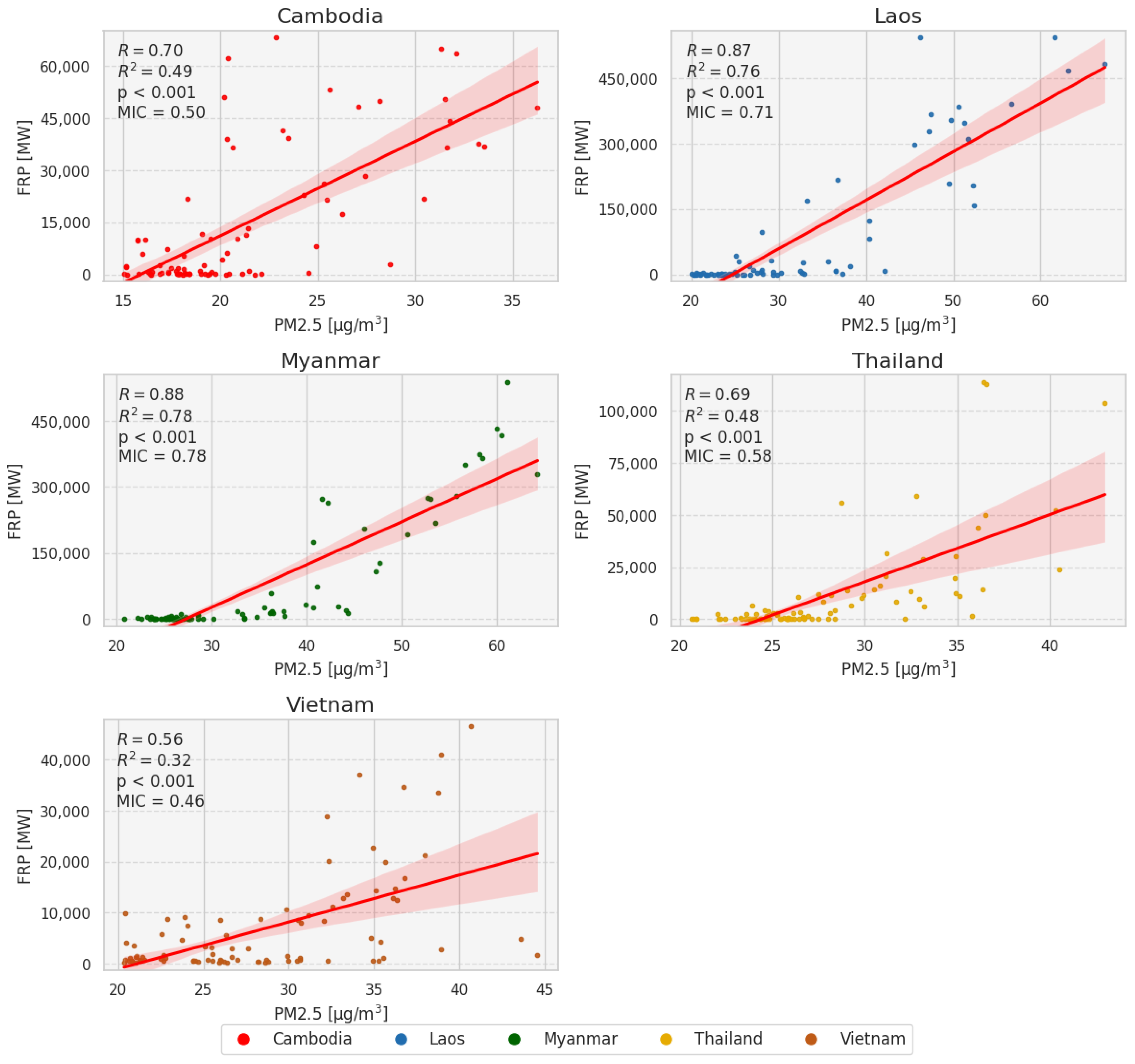
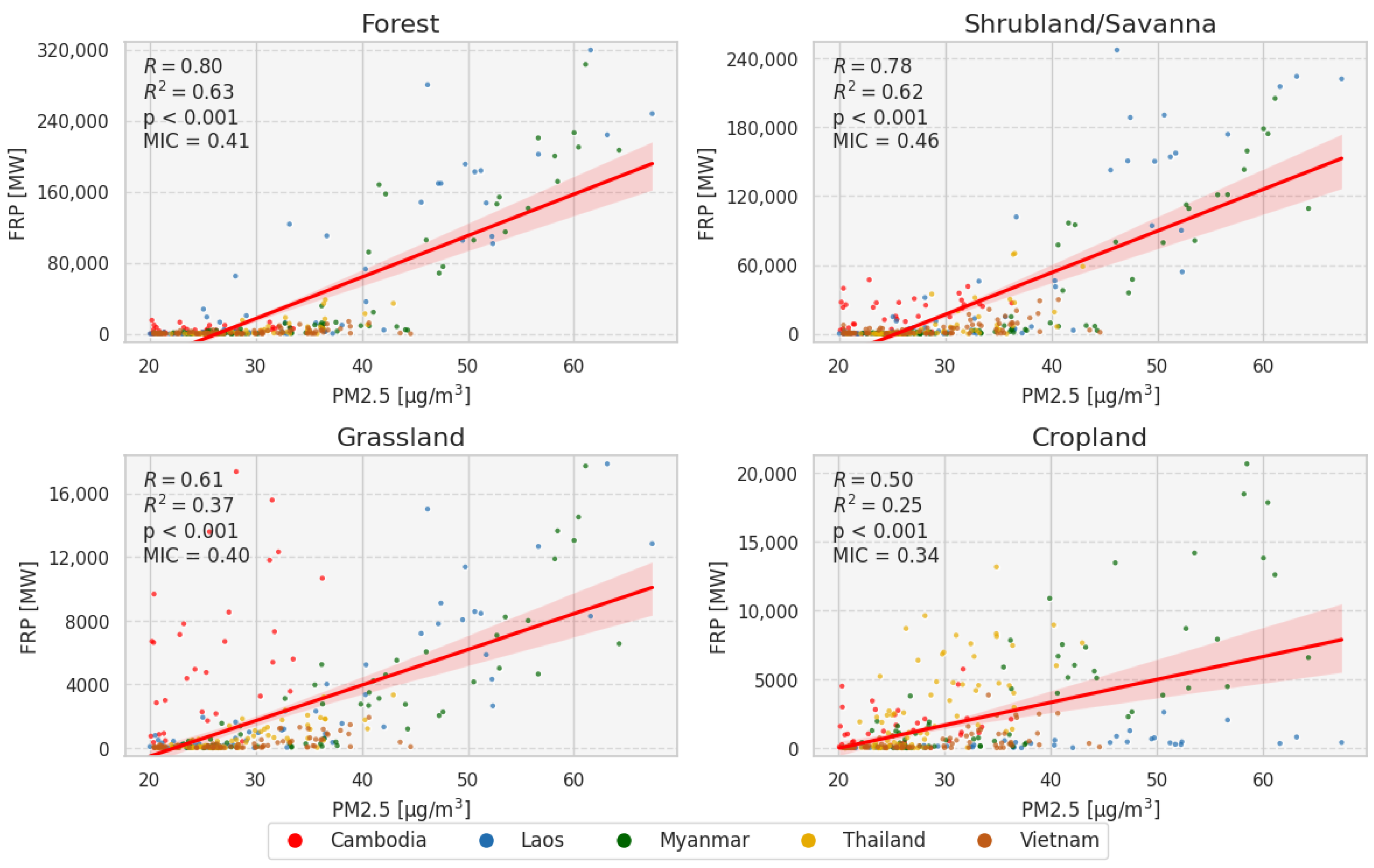
| Land Cover | Cambodia | Laos | Myanmar | Thailand | Vietnam |
|---|---|---|---|---|---|
| Forest | 16.23 | 43.40 | 44.65 | 20.22 | 23.19 |
| Shrubland/Savanna | 59.67 | 50.69 | 39.29 | 38.72 | 61.09 |
| Grassland | 16.54 | 5.26 | 5.16 | 6.63 | 5.00 |
| Cropland | 6.77 | 0.63 | 10.72 | 34.07 | 10.37 |
| Urban | 0.017 | 0.006 | 0.029 | 0.256 | 0.193 |
| Barren | - | - | 0.003 | - | - |
| Water/Permanent Wetland | 0.772 | 0.020 | 0.147 | 0.090 | 0.158 |
| Total Fire Counts | 63,955 | 108,477 | 150,470 | 44,525 | 25,881 |
| Cambodia | Laos | Myanmar | Thailand | Vietnam | ||||||
|---|---|---|---|---|---|---|---|---|---|---|
| Land Cover | Dry | Wet | Dry | Wet | Dry | Wet | Dry | Wet | Dry | Wet |
| Forest | 16.09 | 0.14 | 40.52 | 2.88 | 43.67 | 0.98 | 20.01 | 0.22 | 18.40 | 4.80 |
| Shrubland/Savanna | 58.93 | 0.74 | 49.06 | 1.62 | 38.76 | 0.53 | 37.88 | 0.84 | 51.98 | 9.11 |
| Grassland | 16.04 | 0.50 | 5.17 | 0.09 | 5.08 | 0.08 | 6.47 | 0.16 | 4.29 | 0.70 |
| Cropland | 6.72 | 0.06 | 0.62 | 0.01 | 10.52 | 0.20 | 33.50 | 0.58 | 9.59 | 0.78 |
| Urban | 0.016 | 0.002 | 0.006 | - | 0.028 | 0.001 | 0.238 | 0.018 | 0.128 | 0.066 |
| Barren | - | - | - | - | 0.003 | - | - | - | - | - |
| Water/Permanent Wetland | 0.636 | 0.136 | 0.020 | - | 0.130 | 0.017 | 0.065 | 0.025 | 0.124 | 0.035 |
| Season Proportion | 98.43 | 1.57 | 95.41 | 4.59 | 98.20 | 1.80 | 98.16 | 1.84 | 84.51 | 15.49 |
| Total Fire Counts | 62,954 | 1001 | 103,497 | 4980 | 147,755 | 2715 | 43,704 | 821 | 21,873 | 4008 |
| Land Cover | Cambodia | Laos | Myanmar | Thailand | Vietnam |
|---|---|---|---|---|---|
| Forest | 16.67 | 52.40 | 54.26 | 27.39 | 28.11 |
| Shrubland/Savanna | 60.12 | 44.58 | 38.07 | 47.18 | 61.90 |
| Grassland | 17.47 | 2.76 | 3.15 | 4.22 | 3.83 |
| Cropland | 4.85 | 0.24 | 4.43 | 20.98 | 5.97 |
| Urban | 0.009 | 0.002 | 0.010 | 0.161 | 0.110 |
| Barren | - | - | 0.002 | - | - |
| Water/Permanent Wetland | 0.875 | 0.020 | 0.068 | 0.072 | 0.084 |
| Cumulative FRP [MW] | 1,204,953.29 | 6,377,671.84 | 5,676,410.27 | 994,047.58 | 625,649.22 |
| Cambodia | Laos | Myanmar | Thailand | Vietnam | ||||||
|---|---|---|---|---|---|---|---|---|---|---|
| Land Cover | Dry | Wet | Dry | Wet | Dry | Wet | Dry | Wet | Dry | Wet |
| Forest | 16.53 | 0.14 | 48.00 | 4.40 | 53.20 | 1.07 | 27.24 | 0.15 | 22.41 | 5.70 |
| Shrubland/Savanna | 59.24 | 0.88 | 42.53 | 2.04 | 37.72 | 0.35 | 46.42 | 0.75 | 52.11 | 9.78 |
| Grassland | 17.02 | 0.46 | 2.72 | 0.03 | 3.11 | 0.04 | 4.13 | 0.09 | 3.27 | 0.57 |
| Cropland | 4.82 | 0.03 | 0.24 | 0.003 | 4.37 | 0.06 | 20.67 | 0.31 | 5.54 | 0.43 |
| Urban | 0.007 | 0.001 | 0.002 | - | 0.009 | 0.001 | 0.152 | 0.009 | 0.067 | 0.043 |
| Barren | - | - | - | - | 0.002 | - | - | - | - | - |
| Water/Permanent Wetland | 0.692 | 0.184 | 0.020 | - | 0.062 | 0.006 | 0.045 | 0.027 | 0.061 | 0.023 |
| Cumulative FRP [MW] | 1,184,535.21 | 20,418.08 | 5,964,108.15 | 413,563.69 | 5,589,597.32 | 86,812.95 | 980,705.04 | 13,342.54 | 522,150.54 | 103,498.68 |
Disclaimer/Publisher’s Note: The statements, opinions and data contained in all publications are solely those of the individual author(s) and contributor(s) and not of MDPI and/or the editor(s). MDPI and/or the editor(s) disclaim responsibility for any injury to people or property resulting from any ideas, methods, instructions or products referred to in the content. |
© 2024 by the authors. Licensee MDPI, Basel, Switzerland. This article is an open access article distributed under the terms and conditions of the Creative Commons Attribution (CC BY) license (https://creativecommons.org/licenses/by/4.0/).
Share and Cite
Adaktylou, N.; Stratoulias, D.; Borgman, J.; Cha, S.; Adiningrat, D.P.; Nuthammachot, N. Land Cover Disaggregated Fire Occurrence and Particulate Matter2.5 Relationship in the Mekong Region: A Comprehensive Study. ISPRS Int. J. Geo-Inf. 2024, 13, 206. https://doi.org/10.3390/ijgi13060206
Adaktylou N, Stratoulias D, Borgman J, Cha S, Adiningrat DP, Nuthammachot N. Land Cover Disaggregated Fire Occurrence and Particulate Matter2.5 Relationship in the Mekong Region: A Comprehensive Study. ISPRS International Journal of Geo-Information. 2024; 13(6):206. https://doi.org/10.3390/ijgi13060206
Chicago/Turabian StyleAdaktylou, Nektaria, Dimitris Stratoulias, Julia Borgman, Sangwoo Cha, Devara P. Adiningrat, and Narissara Nuthammachot. 2024. "Land Cover Disaggregated Fire Occurrence and Particulate Matter2.5 Relationship in the Mekong Region: A Comprehensive Study" ISPRS International Journal of Geo-Information 13, no. 6: 206. https://doi.org/10.3390/ijgi13060206
APA StyleAdaktylou, N., Stratoulias, D., Borgman, J., Cha, S., Adiningrat, D. P., & Nuthammachot, N. (2024). Land Cover Disaggregated Fire Occurrence and Particulate Matter2.5 Relationship in the Mekong Region: A Comprehensive Study. ISPRS International Journal of Geo-Information, 13(6), 206. https://doi.org/10.3390/ijgi13060206






